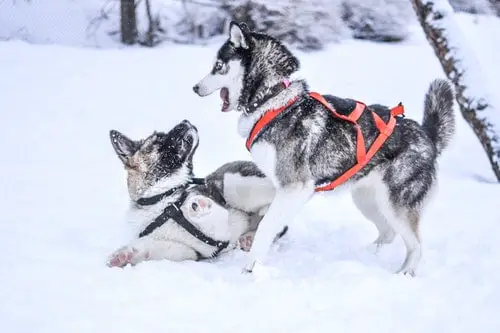Winter is a time when dogs need all the love and care they can get. This is due to the health risk associated with the season which may cause dogs to fall sick or die. For this reason, we have come up with some tips on how you can help your dogs stay warm in winter. No dog, regardless of the breed, should be neglected during winter due to the severity of the weather.

Ways In Which Dogs Stay Warm In Winter
Reduced Metabolic Rate
Dogs stay warm themselves in the winter by reducing their metabolic rate. Reducing metabolic rate helps lower the difference between their body temperature and the air temperature, which reduces the heat emitted from their body. In Excessive cold weather, a dog’s body can create a state of inactiveness or reduced temperature known as torpor [1].
Dogs can be in a state of inactivity for weeks or even days to survive cold periods.
Other methods that dogs can keep warm are making their hair stand up, which reduces the amount of cold air that comes in contact with the skin.
Limited Time Outside
Some dogs have thick fur, which serves as insulation to keep them naturally warm in freezing temperatures, but dogs with thin hair should wear a sweater if going for a walk during winter.
Every dog should be brought inside in the winter because even the most robust breeds developed in artic environments still feel cold. Their ear, nose, and paw are opened and highly susceptible to catch a cold. Dogs should not be left outside for too long.
Lots Of Exercise And Warm dressing
It is encouraged for dogs to still exercise during winter. Just like human beings, dogs need good circulation to build their muscles too. During such exercise outing, Dogs should be worn a thick coat, especially for those with thin fur.
A good coat should be appropriately fitted and waterproofed to prevent freezing. Dog boot that will enable mobility and to avoid falls is also encouraged.
Toasty Bedding
Dogs should not be permitted to sleep on the floor during winter. Instead, a warm bed and a thick blanket should keep the dog warm. Allowing dogs to sleep on a cold tiled or concrete floor will increase the chance of the dog to develop frostbite or hypothermia, which is very harmful to the dog and can even lead to death.

Take Care Of The Paw
Dogs paw might get exposed to ice or salt in the winter, which could pose a threat to the hand or pad. When the dog goes for a walk in the winter, ensure that the paw receives individual attention and the hair between his toes is well-trimmed to prevent ice build-ups. Dog’s paw is highly susceptible to frostbite. The long-haired breed should have the hair between their toes well-trimmed. You can also use booties or a warm cloth to wash the dog’s paw after taking a walk.
Observe Your Dog’s Behavior Regularly
Harsh weather can be very detrimental to the dog’s health, especially if left outside without proper clothing or care. Signs to indicate that your dog is getting cold include; shivering, shaking, slow breathing, weakness, body stiffness, burrowing in warm places. Other symptoms may be subtle. Behavioral changes like pacing, reluctant walk, or whining probably indicate that the dog is feeling cold.
If you notice any of these signs, you should cloth the dog properly, keep it indoors, or call the veterinary doctor for further examination.
Take The Dog Out When It Is Sunny:
Try to take a walk with your dog when the temperature is warm. Always take a step late in the morning or early in the afternoon. Try to let the dog out when the sun is shining as it has an added advantage of providing the dog with vitamin D.
Keep The Dog Moisture
Dogs need to be oiled regularly to avoid dry or flaky skin. Dry skin can be an issue for the dog. Lack of humidity can cause a highly sensitive surface for the dog. Constant itching to relieve the itch can cause more severe skin problems.
Stay Indoors
Dogs should be grounded inside the house during the winter period, especially when the temperature drops less than 40 degrees F. If the dog should stay outside, there should be a provision for a well-heated or insulated house or garage for shelter. Avoid a large-sized home. It is better to keep the dog in an accommodation that is slightly larger than it.

Do Not Overfeed
Dogs need extra layers during winter, but it should not be a layer of fat. Please pay close attention to the dog’s activity level to reduce or improve his calories accordingly. Invest in a meat-based diet and quality foods to ensure the dog remains healthy, energetic, and warm during the winter months.
Dangers Of Exposing Your Dogs To Cold
Even though some dogs have thick fur which acts as insulation to help protect them against extreme cold or may wear a heavy coat, they can still feel cold in winter. Cold can pose severe hazards for them, especially dogs not acclimated to outdoor temperatures or short hair.
Frostbite (frozen skin and tissue) and hypothermia (abnormally low body temperature) are the two most dangerous risks for dogs during winter.
- Frostbite: Dogs start experiencing frostbite when their body begins to get cold. The dog’s body drags blood from the external body parts to the center of the body to keep warm. The most exposed body part of the dog is the tail, ear, and paw. Frostbite is not immediately apparent. Symptoms of frostbite are pale/ grey skin, which makes the skin turn hard and cold and slough off.
- Hypothermia: occurs when a dog spends more time outside in the cold, which may result in shivering or cold feet during mild cases. As hypothermia develops, the dog may begin to be depressed, lethargic, or weak. Hypothermia can be life-threatening for the dog.
When the weather is below 32 degrees, dogs are in danger of developing frostbite or hypothermia. Dogs need to be kept warm.
Glossary
- Science Direct [Link]




